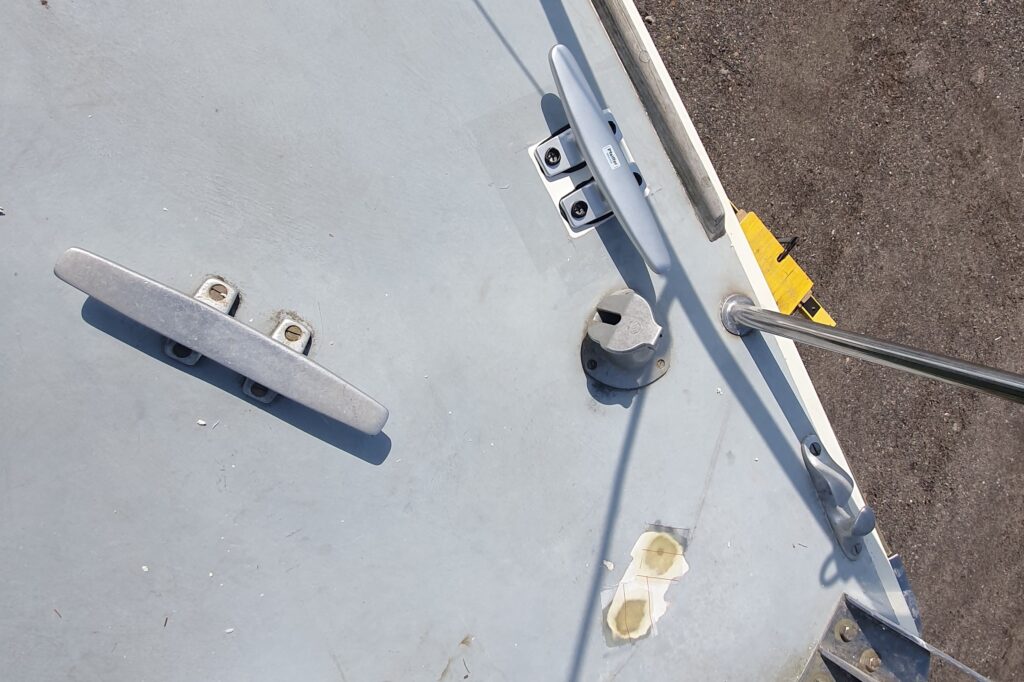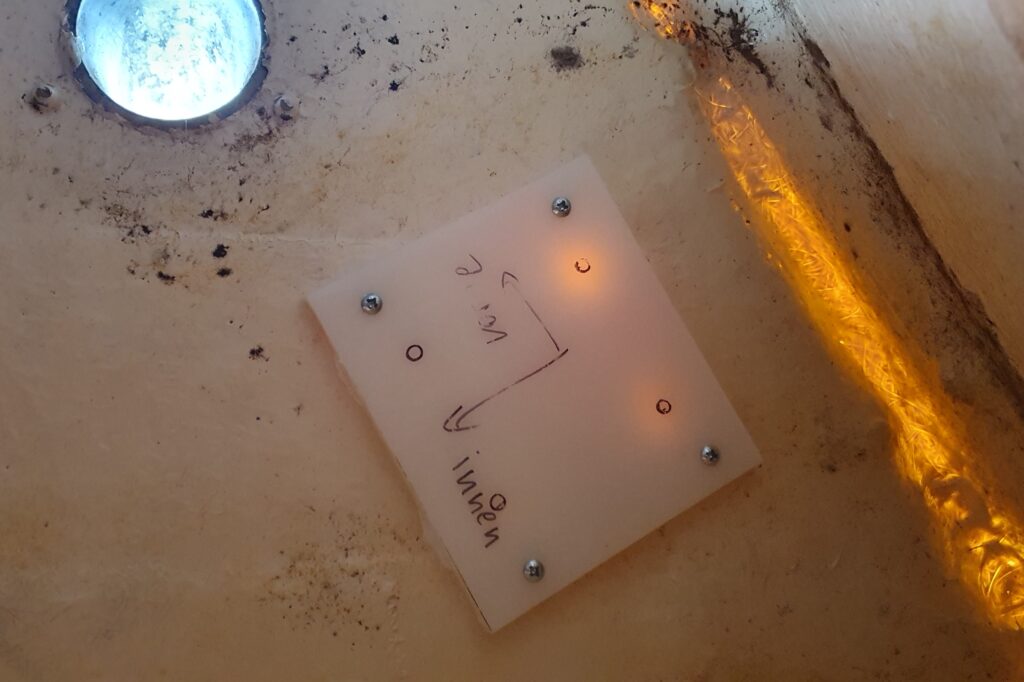Refit 3

Kranen und Mast legen
Die größeren Aufgaben wie Badeplattformen, Kühlschrank, Bugblech, Kielfuge, Gasanlage sind erledigt. Wir überlegen, ob wir endlich die Montage der Ankerwinde angehen sollen, aber dafür ist das Wetter nach wie vor zu unzuverlässig. Also beschränken wir uns an Deck darauf, einen überflüssigen alten Beschlag abzunehmen, die Löcher zu verschließen und die dritte Bugklampe zu montieren.
Am zweiten Mai wird dann das Boot ins Wasser gehoben und der Mast gelegt. Am dritten Mai reist Matthias ab und ich bin für zwei Wochen allein.
Crane and mast laying
The bigger jobs such as the bathing platforms, fridge, bow plate, keel joint and gas system are done. We consider whether we should finally tackle the installation of the anchor windlass, but the weather is still too unreliable for that. So we limit ourselves on deck to removing a superfluous old fitting, plugging the holes and mounting the third bow cleat.
On the second of May, the boat is lifted into the water and the mast is laid. Matthias leaves on the third of May, and I’m on my own for a fortnight.

Trotz Schlechtwetter…
Despite the bad weather…
Bis jetzt sind wir gut vorangekommen, wir haben uns zwar nicht sonderlich beeilt, aber wir haben uns auch kaum einen Ruhetag gegönnt. Wir wussten ja, dass am zweiten Mai der Kran auf uns warten würde und ich wollte den Termin nicht verschieben. Ende April konnten wir aber feststellen, dass alle künftigen Arbeiten auch am schwimmenden Schiff gemacht werden konnten – ein gutes Gefühl!
Also haben wir uns dem Anker bzw. dem Vorschiff gewidmet. Das neue Modell für die Bugrolle wurde noch einmal modifiziert (vergrößert) und einige Details näher definiert, damit der Schlosser weiß, was er zu tun hat.
Für die Epoxid-Arbeiten haben wir die Kette aus dem Kettenkasten in ein Schapp in der Spitze der Vorschiffskabine geschafft. Dabei stellten wir fest, dass der Ketteneinlass an der Seite des Vorschiffs dazu führt, dass sich die Kette an der Bordwand aufstaut und wenn der „Turm“ umfällt, sich die Kette massiv vertörnt. Das wird sich hoffentlich aufhören, wenn der Einlass mittig angebracht sein wird.
We’ve made good progress so far, we haven’t really hurried, but we’ve hardly taken a day off. We knew that the crane would be waiting for us on the second of May, and I didn’t want to postpone the date. At the end of April, however, we realized that all future work could also be carried out on the floating ship – a good feeling!
So we turned our attention to the anchor and the forecastle. The new model for the bow roller was modified again (enlarged) and some details were defined in more detail so that the fitter knows what he has to do.
For the epoxy work, we moved the chain from the chain locker to a locker at the top of the forecastle cabin. We realized that the chain inlet on the side of the foredeck causes the chain to build up on the side of the boat and when the ‘tower’ falls over, the chain becomes massively twisted. This will hopefully stop when the inlet is centred.
Vorbereitung für die Klampe – Präparation for the cleat
Zwei Löcher waren zu füllen – Two holes had to be filled
Aktueller Zustand – Current satus
Unter Deck – Below deck
Für das Kranen ist weiter nicht viel vorzubereiten, Matthias macht noch die Wanten sauber, wir inspizieren den Verlauf der Kabel unter Deck, weil wir für die neuen LED-Lichter im Mast wohl neue Kabel verlegen werden müssen. Was wir dabei entdecken, gefällt uns nicht. Die Kabel sind unter den Abdeckungen im WC nur mit Klebeband befestigt und dieses ist längst zu einem klebrigen Etwas zerfallen. Das werden wir gründlich sanieren müssen, wenn die neuen Kabel zum neuen Schaltkasten geführt werden.
Ich nutze die Gelegenheit und entferne im WC die Vinyl-überzogene Deckenplatte und finde eine Isolierung aus selbstklebendem schwarzen Schaumstoff. Die Sperrholzplatte mit dem Vinyl wird auf der Stelle entsorgt und damit unsere Haare nicht am Kleber haften bleiben wird die Decke mit Plastikfolien abgedeckt – eine neue Baustelle!
There’s not much more to prepare for the crane. Matthias cleans the shrouds and we inspect the cables below deck because we will probably have to lay new cables for the new LED lights in the mast. We don’t like what we discover. The cables under the covers in the toilet are only attached with adhesive tape, which has long since disintegrated into a sticky mess. We will have to clean this up thoroughly when the new cables are routed to the new switch box.
I take the opportunity to remove the vinyl-covered ceiling panel in the toilet and find insulation made of self-adhesive black foam. The plywood panel with the vinyl is disposed of on the spot and the ceiling gets covered with plastic sheeting to prevent our hair from sticking to the adhesive – a new renovation job ahead!
Was wir unter dem Vinyl im WC entdecken gefällt uns nicht besonders
We don’t particularly like what we discover under the vinyl in the WC
Schließlich kommt der Tag, an dem die pepperbird wieder in ihr Element gebracht werden soll. Der Termin ist um 14:30 und wir haben außer zu warten nicht mehr viel zu tun. Mit etwas Verspätung wird sie vom Standplatz geholt und ins Wasser gehoben. Wir diskutieren mit den Leuten vom Kran, was man tun könnte, um Beschädigungen wie im letzten Jahr zu vermeiden. Wir denken, dass die seitlichen Stützen weiter außen angebracht werden sollten, damit die weniger vertikale Last aufnehmen müssen. Dann müsse man den Rumpf in der Mitte zusätzlich abstützen, meinen die Kollegen von der Marina, weil der Kiel nicht das ganze Gewicht tragen könne. Das erscheint mir etwas seltsam – die pepperbird ist bisher immer auf ihrem Kiel gestanden und bisher wurde von den Stützen keinerlei Schaden verursacht, weder in England noch in der Flevo Marina. Ich werde das mit den Freunden von den Westerly Owners klären.
Nachdem das Boot im Wasser ist, gehen Matthias und ich an Bord, um nach potenziellen Lecks zu suchen: die neue Stopfbuchse, der Durchbruch für den Kiel-Kühler, die gewarteten Seeventile – es gibt einige Stellen, wo es Probleme geben könnte. Es gibt sie aber nicht! Alles ist dicht und in bester Ordnung. Also wird die Stopfbuchse entlüftet und der Motor gestartet. Es ist immer wieder eine Freude zu sehen, wie unser alter „Rudolph“ mit einem Druck auf den Startknopf sofort anspringt – selbst nach fast einem Jahr Pause!
Finally, the day arrives when pepperbird is to be returned to her element. The appointment is at 14:30, and we don’t have much to do apart from waiting. A little late, she is taken from her stand and lifted into the water. We discuss with the crane operators what could be done to avoid damage like last year. We think that the side supports should be positioned further out so that they have to bear less vertical load. The colleagues from the marina say that the hull would then have to be additionally supported in the centre because the keel cannot bear the entire weight. This seems a bit strange to me – pepperbird has always stood on her keel and so far no damage has been caused by the supports, neither in England nor in the Flevo Marina. I will clarify this with my friends from the Westerly Owners‘ Association.
After the boat is in the water, Matthias and I go on board to look for potential leaks: the new stuffing box, the breakthrough for the keel cooler, the serviced sea cocks – there are a few places where there could be problems. But there are none! Everything is tight and in perfect order. So the stuffing box is bled, and the engine is started. It’s always a pleasure to see how our old „Rudolph“ starts immediately when you press the start button – even after a break of almost a year!
Beim Mastkran – At the mast-crane
Matthias hilft mit und schaut genau zu – Matthias lends a hand and watches closely
Seit wir die pepperbird gekauft haben, ist es das erste Mal, dass der Mast abgenommen wird und ich schaue genau zu. Die Arbeiter sind sehr routiniert und machen das souverän und flott. Matthias hilft immer wieder mit, während ich den Vorgang dokumentiere. Nach ca. 30 Minuten liegt der Mast auf zwei Böcken, der Baum liegt daneben, die Salinge sind abgenommen, die Leinen sauber aufgeschossen, die Antenne und die Lichter im Masttopp demontiert. So wird der Mast ins Lager gebracht, wo er inspiziert und – wo es erforderlich ist – repariert. Das läuft dann allerdings nicht so routiniert und flott: drei Termine, die mir genannt werden, werden letztlich nicht eingehalten. Schließlich verzögert sich die Inspektion so weit, dass der Mast vor unserer Abreise nicht mehr gestellt werden kann. Einen Kostenvorschlag für die Elektroarbeiten habe ich bis heute (2. Juni) nicht…
Aber davon wissen Matthias und ich glücklicherweise Anfang Mai noch nichts. Wir fahren also zu unserem Liegeplatz – 6B26 – und belohnen uns mit einem kühlen Bier und einem Besuch beim Inder für die tolle Arbeit, die wir in den letzten dreieinhalb Wochen geleistet haben.
This is the first time the mast has been removed since we bought the pepperbird, and I’m watching closely. The workers are very experienced and do it with confidence and speed. Matthias keeps helping out while I document the process. After about 30 minutes, the mast is lying on two supports, the boom is lying next to it, the spreaders are removed, the lines are neatly looped, the antenna and the lights in the masthead are dismantled. The mast is then brought into storage, where it is inspected and – where necessary – repaired. However, this doesn’t go so smoothly and quickly: three deadlines that are given to me are ultimately not met. In the end, the inspection is delayed to such an extent that the mast can no longer be replaced before we leave. To this day (2 June), I still don’t have a quotation for the electrical work…
But fortunately, Matthias and I don’t know anything about that at the beginning of May. So we motor to our berth – 6B26 – and reward ourselves with a cold beer and a visit to the Indian restaurant for the great work we’ve done over the last three and a half weeks.
Der Mast wird abgehoben und die Salinge abmontiert – The mast is lifted off and the spreaders are removed
Morgen bringe ich Matthias mit einem Mietauto zum Bahnhof. Ab dann bin ich vierzehn Tage allein am Boot. Als Erstes werde ich einmal das Deck putzen, das ganze Moos muss endlich entfernt werden. Dann denke ich, dass ich mich um das Vinyl in der Achterkoje und hinter der Steuerbord-Sitzbank kümmern werde (=entfernen und reinigen). Die neuen Deckel unter der Backbord-Sitzbank möchte ich schleifen und ölen und wenn es geht, will ich mit der neuen Lade im WC fertig werden, das würde Hanna sicher freuen.
Tomorrow I’ll take Matthias to the station in a rented car. From then on, I’ll be alone on the boat for a fortnight. The first thing I’m going to do is clean the deck, all the moss has to be removed at last. Then I think I’ll take care of the vinyl in the aft berth and behind the starboard settee (=remove and clean). I want to sand and oil the new covers under the port settee and, if I can, I want to finish with the new drawer in the toilet, which would certainly please Hanna.
Jetzt ist das Ruder geschützt – Now the rudder is protected
Unser Nachbar an Steg 6B – Our neighbour at pier 6B











